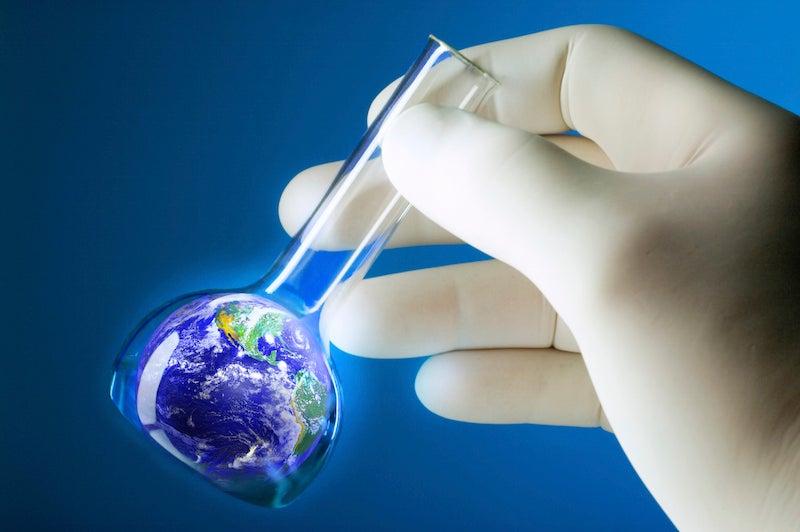5 Ways SLAC’s X-ray Laser Can Change the Way We Live
Toward next-generation electronics, better medications and green energy solutions: "The First Five Years" point to a bright future of high-impact discovery at LCLS.
If you’ve ever stood in a dark room wishing you had a flashlight, then you understand how scientists feel when faced with the mysteries of physical processes that happen at scales that are mind-bogglingly small and fast.
The future of life-changing science – science that will spawn the electronic devices, medications and energy solutions of the future – depends on being able to see atoms and molecules at work.
To do that you need special light – such as X-ray light with a wavelength as small as an atom – that pulses at the rate of femtoseconds. A femtosecond is to a second what a second is to 32 million years. It is the timescale for the basic building blocks of chemistry, biology and materials science.
That’s why, six years ago, the Department of Energy’s SLAC National Accelerator Laboratory answered a bold call by the scientific community: Build a transformative tool for discovery, an X-ray laser so bright and fast it can unravel the hidden dynamics of our physical world.
Since it began operation in 2009, this singularly powerful “microscope” has generated molecular movies, gotten a glimpse of the birth of a chemical bond, traced electrons moving through materials and made 3-D pictures of proteins that are key to drug discovery. Known to scientists as an X-ray free-electron laser (XFEL), SLAC's Linac Coherent Light Source, or LCLS, is a DOE Office of Science User Facility that draws many hundreds of scientists from around the world each year to perform innovative experiments.
The success of LCLS has inspired the spread of such machines all over the world.
The latest issue of Reviews of Modern Physics contains the most comprehensive scientific overview of its accomplishments in a paper entitled, "Linac Coherent Light Source: The First Five Years."
LCLS staff scientists devoted about a year to compiling the collection of reports, says LCLS Director Mike Dunne.
"We hope this extensive paper will be a valuable go-to source for this new field of science,” he said. “It describes many of the major accomplishments of the first X-ray laser of its kind. It also testifies to the power of this unique tool for scientific discovery that will benefit society in many ways."
Here are five ways SLAC’s X-ray laser and the science it enables can impact our future.
1. Next-generation Computers and the Power Grid

LCLS studies are helping to home in on the most promising materials and methods for transforming the electric power grid and driving next-generation computer components beyond classical limits.
To make computers and other electronics faster and smaller, scientists need to understand and control materials’ magnetism and electronic behavior in new and more precise ways.
LCLS has given us new, nanoscale views of how laser light rapidly flips the magnetic state of materials, providing new insight on how to write data with light. It has pinpointed the speed of electrical switching – such as what occurs in semiconductor transistors – with trillionth-of-a-second precision.
Researchers at LCLS have also discovered a new, 3-D phenomenon that may be linked to high-temperature superconductivity, which allows some exotic materials to conduct electricity with zero resistance.
2. Better, Cleaner Fuels and Chemicals

The ability to take direct measurements of never-before-seen steps in chemical reactions is what scientists need to design more efficient reactions to produce fuels, fertilizers and industrial chemicals.
While we know the starting ingredients and outcomes of chemical reactions, the early and middle steps are hard to see in real time at the atomic scale.
LCLS X-ray pulses are so fast that they allow us to observe and analyze these previously unseen steps. They work like ultrabright flashes to capture X-ray snapshots of chemical reactions as they happen.
Researchers have used LCLS to see new details of a reaction in catalytic converters that neutralizes pollution from car exhaust, and to produce “molecular movies” of a molecule transforming after one of its chemical bonds breaks.
3. More Effective Medication with Fewer Side Effects

Half of the medications on the market target special receptor proteins in the outer layer of our cells. To figure out how drugs work so we can make them more effective and reduce side effects, we need to see how they dock with these receptors in atom-by-atom detail.
The best way to see how they fit is to form the protein-drug complexes into crystals and study them with X-rays, but many important samples don’t form big enough crystals or are too damage-prone for conventional X-ray tools. LCLS, though, can study very tiny crystals under more natural conditions, making it possible to determine the 3-D atomic structure of important proteins that had been out of reach.
Already, LCLS has revealed a potential weakness in a protein involved in the transmission of African sleeping sickness, provided the best 3-D atomic-scale look at how blood pressure medicines and painkillers interact with receptors in our cells, and pinpointed the mechanism that allows our brain to send ultrafast chemical signals.
In more recent studies, LCLS has also been used to image living bacteria that are responsible for generating the oxygen in our atmosphere, demonstrating an entirely new X-ray imaging technique.
4. Renewable Energy that Mimics Nature

LCLS allows us to study how plants use energy from sunlight to release oxygen into the air we breathe during a process called photosynthesis. The X-ray laser is uniquely capable of mapping the individual sunlight-triggered steps. Early data is already giving us a detailed understanding of photosynthesis – information that’s crucial for developing renewable, clean sources of energy that mimic nature.
Scientists are also using the tool to study how light affects other living things. Just as sunlight can be life-giving, it can also be damaging. Studies at LCLS have revealed how our DNA protects itself from the sun’s ultraviolet rays and how proteins in bacteria and in our eyes shift shape in response to light.
5. Fusion Reactions and Seeing Inside Planets

High-power laser systems at SLAC heat matter to millions of degrees and crush it with billions of tons of pressure per square inch. Scientists use LCLS to measure what happens to matter under these extreme conditions with high precision at very small scales, and over very short periods of time.
Some studies test the resilience of materials, such as those used in jet engines, to see how they fail. Others have simulated and studied the shock effects of meteorite impacts and have reproduced the conditions that are believed to exist at the heart of giant gas planets, which improves our understanding of how solar systems form.
The results also give scientists new insight into how to replicate the fusion reactions that fuel our sun, an essential step in the pursuit of fusion energy as a power source.
Looking to the Future
"Many of the methods developed over the first years of LCLS operations responded to the needs of science to address vital areas of discovery that promise to have a significant impact on our lives," Dunne emphasizes. "We expect that the coming years of XFEL innovation will push us further into the future, as we look ever deeper into the dynamics of our natural world."
"The Linac Coherent Light Source: The First Five Years," was authored by a team representative of the X-ray and accelerator science groups at SLAC during this pioneering period of XFEL science: Christoph Bostedt, Sébastien Boutet, David M. Fritz, Zhirong Huang, Hae Ja Lee, Henrik T. Lemke, Aymeric Robert, William F. Schlotter, Joshua J. Turner and Garth J. Williams.
Citation: Bostedt, et al., Reviews of Modern Physics, 9 March 2016 (10.1103/RevModPhys.88.015007).
For questions or comments, contact the SLAC Office of Communications at communications@slac.stanford.edu.

About SLAC
SLAC National Accelerator Laboratory explores how the universe works at the biggest, smallest and fastest scales and invents powerful tools used by researchers around the globe. As world leaders in ultrafast science and bold explorers of the physics of the universe, we forge new ground in understanding our origins and building a healthier and more sustainable future. Our discovery and innovation help develop new materials and chemical processes and open unprecedented views of the cosmos and life’s most delicate machinery. Building on more than 60 years of visionary research, we help shape the future by advancing areas such as quantum technology, scientific computing and the development of next-generation accelerators.
SLAC is operated by Stanford University for the U.S. Department of Energy’s Office of Science. The Office of Science is the single largest supporter of basic research in the physical sciences in the United States and is working to address some of the most pressing challenges of our time.




